Question Number 91843 by jagoll last updated on 03/May/20
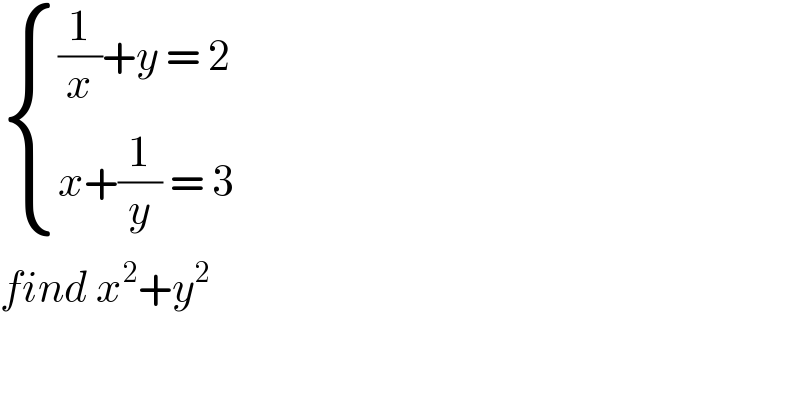
$$\begin{cases}{\frac{\mathrm{1}}{{x}}+{y}\:=\:\mathrm{2}}\\{{x}+\frac{\mathrm{1}}{{y}}\:=\:\mathrm{3}}\end{cases} \\ $$$${find}\:{x}^{\mathrm{2}} +{y}^{\mathrm{2}} \\ $$
Commented by jagoll last updated on 03/May/20
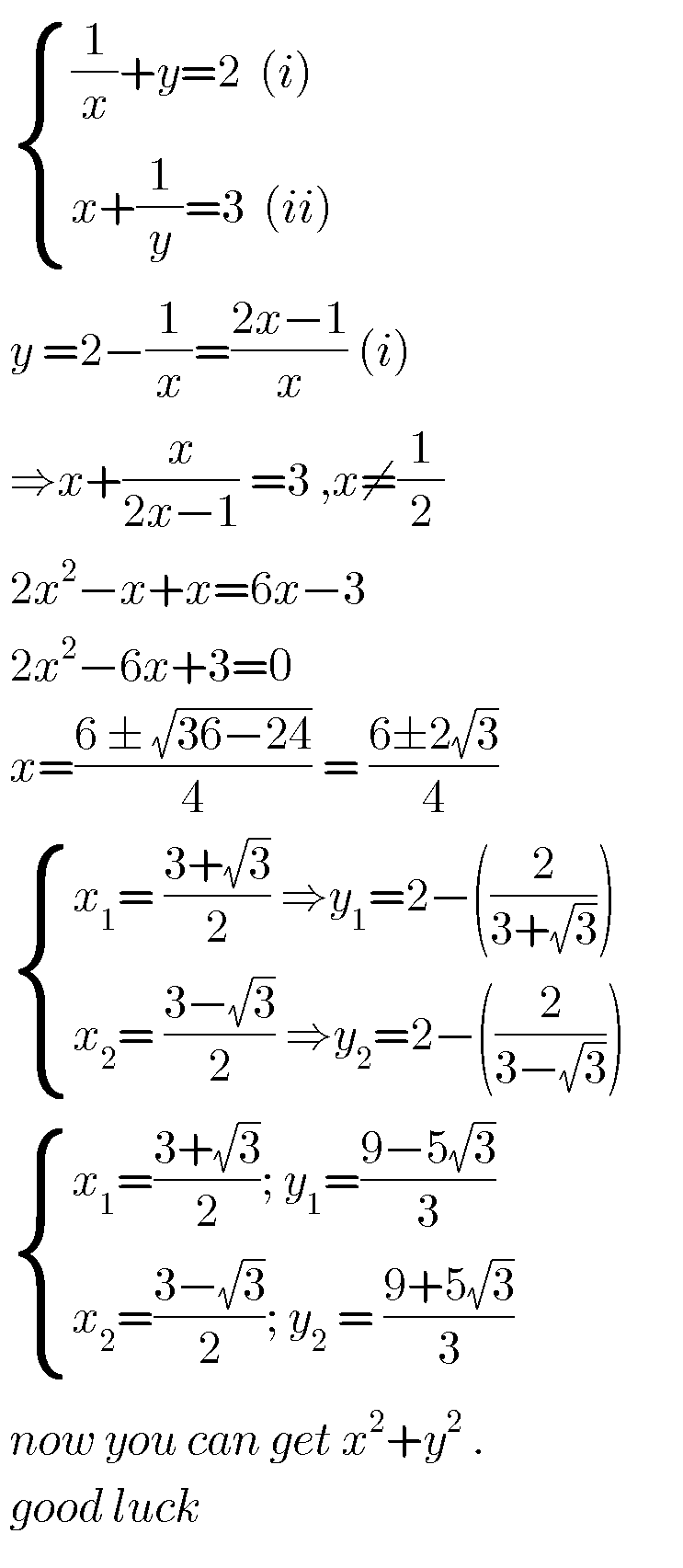
Commented by jagoll last updated on 03/May/20
��������
Commented by john santu last updated on 03/May/20
��������
Commented by Prithwish Sen 1 last updated on 03/May/20
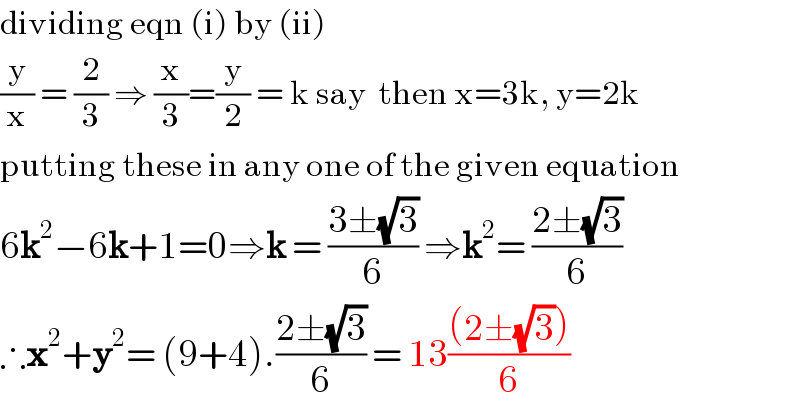
$$\mathrm{dividing}\:\mathrm{eqn}\:\left(\mathrm{i}\right)\:\mathrm{by}\:\left(\mathrm{ii}\right) \\ $$$$\frac{\mathrm{y}}{\mathrm{x}}\:=\:\frac{\mathrm{2}}{\mathrm{3}}\:\Rightarrow\:\frac{\mathrm{x}}{\mathrm{3}}=\frac{\mathrm{y}}{\mathrm{2}}\:=\:\mathrm{k}\:\mathrm{say}\:\:\mathrm{then}\:\mathrm{x}=\mathrm{3k},\:\mathrm{y}=\mathrm{2k} \\ $$$$\mathrm{putting}\:\mathrm{these}\:\mathrm{in}\:\mathrm{any}\:\mathrm{one}\:\mathrm{of}\:\mathrm{the}\:\mathrm{given}\:\mathrm{equation} \\ $$$$\mathrm{6}\boldsymbol{\mathrm{k}}^{\mathrm{2}} −\mathrm{6}\boldsymbol{\mathrm{k}}+\mathrm{1}=\mathrm{0}\Rightarrow\boldsymbol{\mathrm{k}}\:=\:\frac{\mathrm{3}\pm\sqrt{\mathrm{3}}}{\mathrm{6}}\:\Rightarrow\boldsymbol{\mathrm{k}}^{\mathrm{2}} =\:\frac{\mathrm{2}\pm\sqrt{\mathrm{3}}}{\mathrm{6}} \\ $$$$\therefore\boldsymbol{\mathrm{x}}^{\mathrm{2}} +\boldsymbol{\mathrm{y}}^{\mathrm{2}} =\:\left(\mathrm{9}+\mathrm{4}\right).\frac{\mathrm{2}\pm\sqrt{\mathrm{3}}}{\mathrm{6}}\:=\:\mathrm{13}\frac{\left(\mathrm{2}\pm\sqrt{\mathrm{3}}\right)}{\mathrm{6}} \\ $$
Commented by jagoll last updated on 03/May/20
��✒️
Answered by mr W last updated on 03/May/20
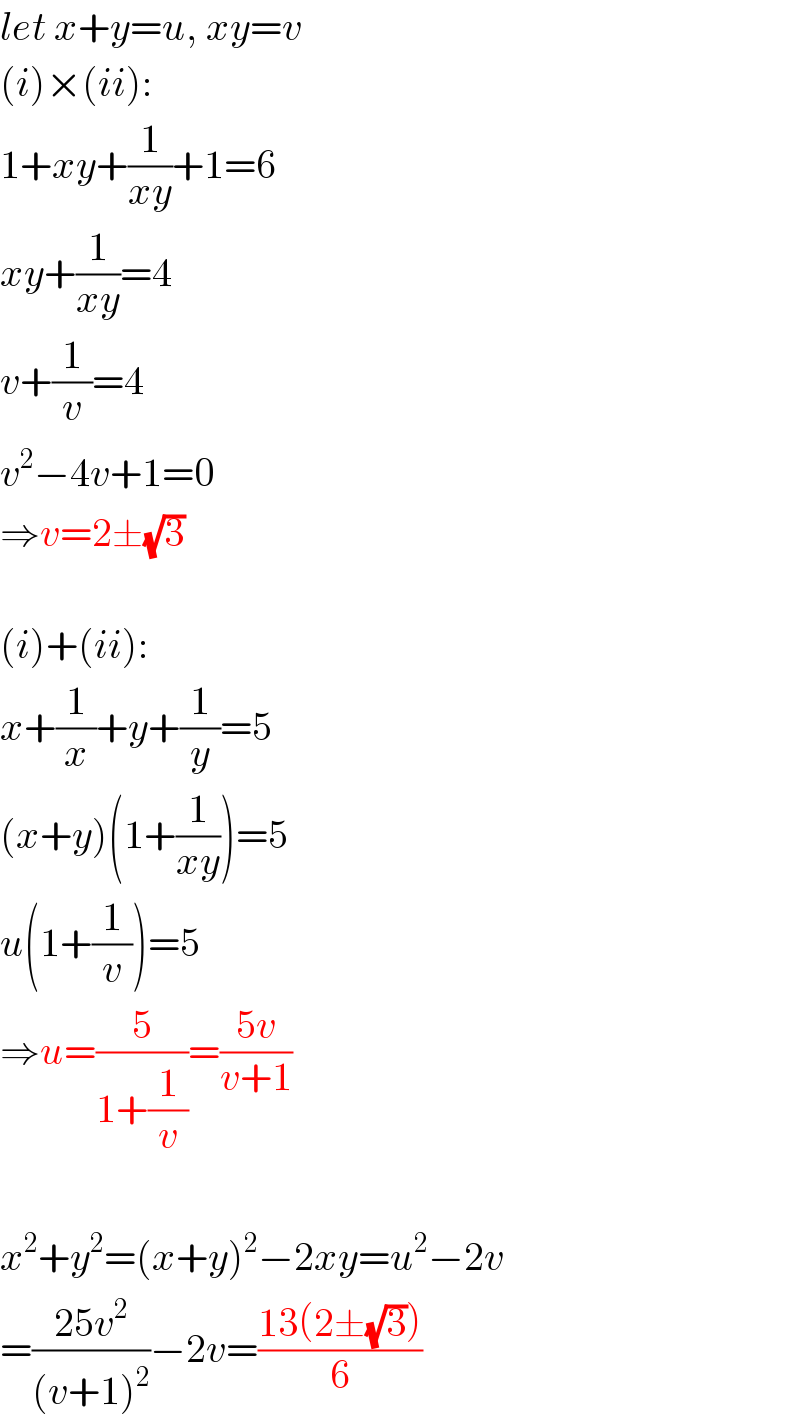
$${let}\:{x}+{y}={u},\:{xy}={v} \\ $$$$\left({i}\right)×\left({ii}\right): \\ $$$$\mathrm{1}+{xy}+\frac{\mathrm{1}}{{xy}}+\mathrm{1}=\mathrm{6} \\ $$$${xy}+\frac{\mathrm{1}}{{xy}}=\mathrm{4} \\ $$$${v}+\frac{\mathrm{1}}{{v}}=\mathrm{4} \\ $$$${v}^{\mathrm{2}} −\mathrm{4}{v}+\mathrm{1}=\mathrm{0} \\ $$$$\Rightarrow{v}=\mathrm{2}\pm\sqrt{\mathrm{3}} \\ $$$$ \\ $$$$\left({i}\right)+\left({ii}\right): \\ $$$${x}+\frac{\mathrm{1}}{{x}}+{y}+\frac{\mathrm{1}}{{y}}=\mathrm{5} \\ $$$$\left({x}+{y}\right)\left(\mathrm{1}+\frac{\mathrm{1}}{{xy}}\right)=\mathrm{5} \\ $$$${u}\left(\mathrm{1}+\frac{\mathrm{1}}{{v}}\right)=\mathrm{5} \\ $$$$\Rightarrow{u}=\frac{\mathrm{5}}{\mathrm{1}+\frac{\mathrm{1}}{{v}}}=\frac{\mathrm{5}{v}}{{v}+\mathrm{1}} \\ $$$$ \\ $$$${x}^{\mathrm{2}} +{y}^{\mathrm{2}} =\left({x}+{y}\right)^{\mathrm{2}} −\mathrm{2}{xy}={u}^{\mathrm{2}} −\mathrm{2}{v} \\ $$$$=\frac{\mathrm{25}{v}^{\mathrm{2}} }{\left({v}+\mathrm{1}\right)^{\mathrm{2}} }−\mathrm{2}{v}=\frac{\mathrm{13}\left(\mathrm{2}\pm\sqrt{\mathrm{3}}\right)}{\mathrm{6}} \\ $$
Commented by jagoll last updated on 03/May/20
����
Answered by MJS last updated on 03/May/20
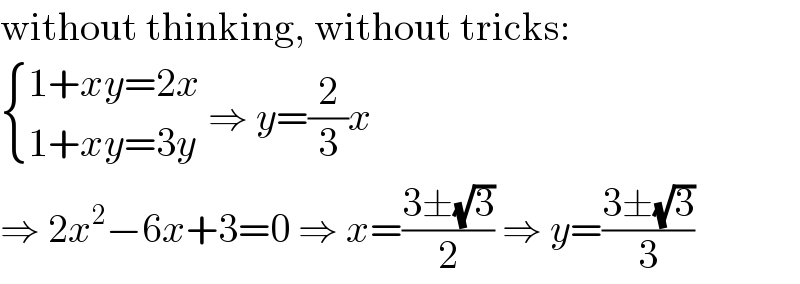
$$\mathrm{without}\:\mathrm{thinking},\:\mathrm{without}\:\mathrm{tricks}: \\ $$$$\begin{cases}{\mathrm{1}+{xy}=\mathrm{2}{x}}\\{\mathrm{1}+{xy}=\mathrm{3}{y}}\end{cases}\:\Rightarrow\:{y}=\frac{\mathrm{2}}{\mathrm{3}}{x} \\ $$$$\Rightarrow\:\mathrm{2}{x}^{\mathrm{2}} −\mathrm{6}{x}+\mathrm{3}=\mathrm{0}\:\Rightarrow\:{x}=\frac{\mathrm{3}\pm\sqrt{\mathrm{3}}}{\mathrm{2}}\:\Rightarrow\:{y}=\frac{\mathrm{3}\pm\sqrt{\mathrm{3}}}{\mathrm{3}} \\ $$
Commented by jagoll last updated on 03/May/20
��������������
Commented by Ar Brandon last updated on 03/May/20
�� Brilliant !
